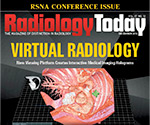 |
Image sharing and interoperability are hot health care topics, but matching images with patients and getting technological systems to talk with each other are not small feats. To advance those goals, RSNA recently joined the CommonWell Health Alliance. To learn more, check out this month’s e-News Exclusive.
— Dave Yeager, editor |
 |
 |
RSNA Becomes Member of CommonWell Health Alliance
RSNA announces it is joining CommonWell Health Alliance as a general member to help break down barriers to nationwide data exchange. CommonWell, a nonprofit trade association, is dedicated to the vision that health data should be available regardless of where care occurs.
According to Black Book, 94% of America’s providers, health care agencies, patients, and payers persist as meaningfully unconnected. In an effort to improve the status quo, CommonWell and its members have committed to using their diverse experience across the health care continuum to produce and deploy real-world, cross-vendor interoperability services that will contribute to improved health care delivery and outcomes for providers and the people they serve.
CommonWell and its members are actively deploying these interoperability services, which are now live at 4,700 provider sites nationwide, ranging from large acute hospitals to rural specialty practices. CommonWell services include person enrollment, record location, patient identification and linking, and data query and retrieval across the health care continuum. Unique to CommonWell, its services aim to solve the patient linking and identity problems at scale. Additionally, CommonWell members have access to a working, functioning record locator service, allowing providers to find health records associated with a patient, no matter where the care is delivered. Services are built into the software by CommonWell member companies to help providers maintain their existing workflow.
Full story » |
 |
|
|
 |
“It's a natural reaction for radiologists to think the computer is going to replace them, but this fear represents an oversimplification of what a computer can do and what the profession of radiology is. What machine learning can do is help remove the humdrum and make the profession more exciting and vibrant.”
— Bradley J. Erickson, MD, PhD, a radiologist at Mayo Clinic, on the integration of artificial intelligence into radiology, as reported by RSNA
|
 |
|
